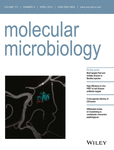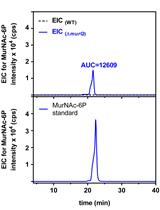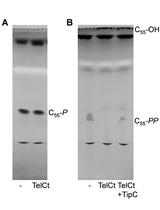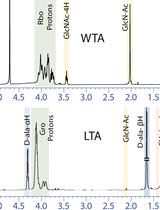- EN - English
- CN - 中文
Purification and HPLC Analysis of Cell Wall Muropeptides from Caulobacter crescentus
新月形杆菌细胞壁膜多肽的纯化和HPLC分析
发布: 2019年11月05日第9卷第21期 DOI: 10.21769/BioProtoc.3421 浏览次数: 6057
评审: Alexandros AlexandratosMelike ÇağlayanSteven Boeynaems
Abstract
The peptidoglycan sacculus, or cell wall, is what defines bacterial cell shape. Cell wall composition can be best characterized at the molecular level by digesting the peptidoglycan murein polymer into its muropeptide subunits and quantifying the abundance of muropeptides using high-pressure liquid chromatography. Certain features of the cell wall including muropeptide composition, glycan strand length, degree of crosslinking, type of crosslinking and other peptidoglycan modifications can be quantified using this approach. Well-established protocols provide us with highly-resolved and quantitatively reproducible chromatographic data, which can be used to investigate bacterial cell wall composition under a variety of environmental or genetic perturbations. The method described here enables the purification of muropeptide samples, their quantification by HPLC, and fraction collection for peak identification by mass spectrometry. Although the methods for peptidoglycan purification and HPLC analysis have been previously published, our method includes important details on how to re-equilibrate the column between runs to allow for automated analysis of multiple samples.
Keywords: LD-crosslinks (LD交联)Background
Most bacteria are encased in a rigid mesh-like protective layer called peptidoglycan (PG) that is synthesized during cell growth and division. PG is a continuous polymer network made of glycan strands consisting of alternating N-acetylglucosamine (GlcNAc) and N-acetylmuramic acid (MurNAc) sugars linked by β (1→4) bonds. Peptide stems attached to the MurNAc sugars are the site of PG crosslinking. While the glycan sugars are largely-conserved in Gram-negative and Gram-positive species, the sugar backbone can be modified via N-deacetylation, N-glycolylation and O-acetylation. These modifications provide resistance to host defense mechanisms against infections, namely lysozyme resistance (Vollmer, 2008). By contrast, the compositions of the peptide strands vary significantly. During pentapeptide synthesis the bacterial family of Mur-ligases can introduce a variety of amino acids at each position of the pentapeptide stem. For example, at the third position of the pentapeptide most Gram-negative species incorporate meso-diaminopimelic acid (mDAP), while most Gram-positives insert L-lysine, although other variations have also been reported (Vollmer, 2008). Additionally, the peptide stem can be modified after synthesis. For instance, Corynebacteriales are reported to modify the third residue meso-Diaminopimelic acid via amidation once peptide synthesis has occurred (Levefaudes et al., 2015). Another aspect of peptidoglycan variation is the type of crosslinking used to connect multiple glycan strands (Schleifer and Kandler, 1972). Transpeptidation by DD-transpeptidases creates a 3-4 cross-linkage between third-position mDAP and fourth-position D-alanine. LD-transpeptidases, by contrast, form 3-3 crosslinks between two mDAP residues.
The sacculus, which provides the cell its architectural framework, also plays a large number of physiological roles in activating the immune system, aiding in colonization, evading antibiotics and host-responses, as well as inter-species recognition (Clarke and Weiser, 2011; Royet et al., 2011; Mesnage et al., 2014). Using high-resolution imaging (cryo-electron tomography and atomic force microscopy) and computational modeling, studies have begun to explain how cell wall composition effects the biophysical properties of cells (Tocheva et al., 2013; de Pedro and Cava, 2015). Genetic and cell biology approaches have demonstrated the role of LD-transpeptidation in mediating lysozyme resistance and bacterial virulence (Schleifer and Kandler, 1972; Schoonmaker et al., 2014; Stankeviciute et al., 2019). Thus, HPLC is a powerful tool to connect PG composition and structure to its physiological impact.
Materials and Reagents
- 50 ml polypropylene conical tubes (Nunc, catalog number: 339653)
- Micro magnetic stir bar (Science ware, catalog number: F37121-0012)
- 2.0 ml Safe-lock microcentrifuge tubes (Eppendorf, catalog number: 022363352)
- 1.7 ml microcentrifuge tubes (VWR, catalog number: 87003-294)
- MColorpHast pH test strips (pH 0-6) (Millipore Sigma, catalog number: 1095310001)
- 1 ml syringe (Becton Dickinson, catalog number: 309597)
- Millex-GV syringe filter unit, 0.22 µm (Millipore Sigma, catalog number: SLGV033R)
- 12 x 32 mm screw neck HPLC vials (Waters, catalog number: 186000273)
- Bottle top vacuum filter (VWR, catalog number: 10040-468)
- Caulobacter crescentus strain NA1,000 (Laboratory strain, available upon request)
- Bactopeptone (BD Biosciences, catalog number: 211677)
- Yeast extract (BD Biosciences, catalog number: 212750)
- Magnesium sulfate heptahydrate (MgSO4·7H2O) (Fisher, catalog number: BP213)
- Calcium chloride dihydrate (CaCl2·2H2O) (Fisher, catalog number: BP510)
- Ethylenediaminetetraacetic acid (EDTA) (Fisher, catalog number: BP118)
- Zinc sulfate heptahydrate (ZnSO4·7H2O) (Millipore Sigma, catalog number: Z0251)
- Iron sulfate heptahydrate (FeSO4·7H2O) (ACROS Organics, catalog number: 423730050)
- Manganese sulfate hydrate (MnSO4·7H2O) (Millipore Sigma, catalog number: M7634)
- Copper (II) sulfate pentahydrate (CuSO4·5H2O) (Millipore Sigma, catalog number: 209918)
- Cobalt (II) nitrate hexahydrate (Co(NO3)2·6H2O) (Millipore Sigma, catalog number: 239267)
- Sodium tetraborate decahydrate (Na2B4O7·10H2O) (Millipore Sigma, catalog number: B9876)
- Sulfuric acid (Millipore Sigma, catalog number: 320501)
- Nitrilotriacetic acid (C6H9NO6) (Millipore Sigma, catalog number: N9877)
- Ammonium heptamolybdate tetrahydrate (NH4Mo7O24) (Millipore Sigma, catalog number: 09878)
- Sodium phosphate dibasic (Na2HPO4) (Fisher, catalog number: BP331)
- Potassium phosphate monobasic (KH2PO4) (Fisher, catalog number: P285)
- Imidazole (Millipore Sigma, catalog number: I2399)
- Glucose (Fisher, catalog number: D16500)
- Sodium glutamate (Millipore Sigma, catalog number: 49621)
- Ammonium chloride (NH4Cl) (Fisher, catalog number: A661)
- Sodium dodecyl sulfate (SDS) (Millipore Sigma, catalog number: L3771)
- Pronase E (VWR, catalog number: VE629)
- Tris base (Fisher, catalog number: BP152)
- Sodium chloride (NaCl) (Fisher, catalog number: BP358)
- Mutanolysin from Streptomyces globisporus ATCC 21553 (Millipore Sigma, catalog number: M9901)
- Phosphoric acid (H3PO4) (Millipore Sigma, catalog number: 79607)
- Sodium hydroxide (NaOH) (Fisher, catalog number: S318)
- Boric acid (H3BO3) (Millipore Sigma, catalog number: B6768)
- Sodium borohydride (NaBH4) (Millipore Sigma, catalog number: 452882)
- HPLC-grade methanol (Millipore Sigma, catalog number: 34860)
- Sodium azide (NaN3) (Fisher, catalog number: BP9221)
- Peptone-Yeast Extract (PYE) media (see Recipes)
- Hutner-Imidazole-Glucose-Glutamate (HIGG) growth media (see Recipes)
- Concentrated Hutner base (per 1 L) (see Recipes)
- 0.5 M Phosphate buffer, pH 7.0 (see Recipes)
- HIGG media (see Recipes)
- Pronase E buffer (see Recipes)
- 50 mM phosphate buffer (pH 4.9) (see Recipes)
- 500 mM borate buffer (pH 9) (see Recipes)
- HPLC Buffer A (see Recipes)
- HPLC Buffer B (see Recipes)
Equipment
- ELGA PURELAB Flex 3 water purification system (ELGA LabWater)
- Magnetic hot plate-stirrer (Thermo Scientific, catalog number: SP195025)
- Sorvall Lynx 6000 Centrifuge (Thermo Scientific)
- 50 ml conical tube centrifuge rotor (Thermo Scientific, catalog number: Fiberlite F14-14x50cy)
- pH meter (Fisher, catalog number: 13-636-AB150)
- Sorvall WX 80+ ultracentrifuge (Thermo Scientific, catalog number: 75000080)
- Swinging bucket rotor TH-641 (Thermo Scientific, catalog number: 54295)
- 14 x 89 mm thickwall polycarbonate tube for TH-641 rotor (Seton Scientific 2013)
- Fixed angle rotor T-1270 (Thermo Scientific, catalog number: 08259)
- 16 x 76 mm thickwall polycarbonate tube for T-1270 rotor (Seton Scientific 2004)
- Digital dry bath (Fisher, catalog number: 88-871-001)
- 6 x 1.5 ml block for dry bath (Fisher, catalog number: 88-871-103)
- 6 x 2.0 ml block for dry bath (Fisher, catalog number: 88-871-104)
- Microcentrifuge (Eppendorf, model: 5424)
- Glass culture tubes (13 x 100 mm) (Fisher, catalog number: 14-961-27)
- Microspatula (Fisher, catalog number: S50823)
- Vortexer (Fisher, catalog number: 02-215-414)
- Agilent 1260 Infinity II HPLC system including:
- Agilent 1260 Infinity II Quaternary pump
- Agilent 1260 Infinity II Multisampler
- Agilent 1260 Infinity II Multicolumn thermostat
- Agilent 1260 Infinity II Diode array detector (DAD)
- Agilent 1260 Infinity II Quaternary Pump
- Agilent 1260 Infinity II Analytical-scale fraction collector
- Hypersil ODS C18 HPLC column (3 µm particles, 4.6 mm diameter, 250 mm length) (Thermo Scientific, catalog number: 30103-254630)
- Uniguard guard cartridge holder (Thermo Scientific, catalog number: 850-00)
- Hypersil ODS C18 guard cartridge (3 µm particles, 4 mm diameter, 10 mm length) (Thermo Scientific, catalog number: 30103-014001)
- Vacufuge concentrator (Eppendorf, model: 022820109)
Software
- Matlab R2018b (Mathworks)
- Chromanalysis v. 1.0 (Desmarais et al., 2015)
Procedure
文章信息
版权信息
© 2019 The Authors; exclusive licensee Bio-protocol LLC.
如何引用
Stankeviciute, G. and Klein, E. A. (2019). Purification and HPLC Analysis of Cell Wall Muropeptides from Caulobacter crescentus. Bio-protocol 9(21): e3421. DOI: 10.21769/BioProtoc.3421.
分类
微生物学 > 微生物生理学 > 细胞壁
生物化学 > 糖类 > 肽聚糖
您对这篇实验方法有问题吗?
在此处发布您的问题,我们将邀请本文作者来回答。同时,我们会将您的问题发布到Bio-protocol Exchange,以便寻求社区成员的帮助。
Share
Bluesky
X
Copy link














